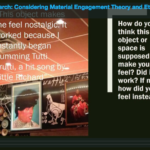
JONATHAN BEAN
University of Arizona
BERNARDO FIGUEIREDO
RMIT University
HANNE PICO LARSEN
Copenhagen Business School
Download PDF
[s2If current_user_can(access_s2member_level1)]
[/s2If]
The paper outlines a methodological approach for investigating how consumers create brand meaning using the material resources companies provide. The approach draws from Material Engagement Theory—to discuss the role of consumers in creating patterns of meaning by engaging with objects. It also explicates the role of objects in supporting this patterning. We explain how an in-situ diary tool (dscout, in our case) can be useful to support this approach. We demonstrate our methodological approach in the context of the Red Rooster Harlem, a cosmopolitan restaurant in New York, owned by the celebrity Chef Marcus Samuelsson.
[s2If current_user_is(subscriber)]
Become a member to access video. Learn More.
[/s2If]
[s2If !is_user_logged_in()]
FREE ARTICLE!
Please sign in or create a free account to access the leading collection...




